Images
« The ENVOY : But have things ever happened otherwise? History was lived so that a glorious page might be written, and then read. It’s reading that counts. (To the photographers) Gentlemen, the Queen informs me that she congratulates you. She asks that you return to your posts. » Jean Genet, Le Balcon, 1956
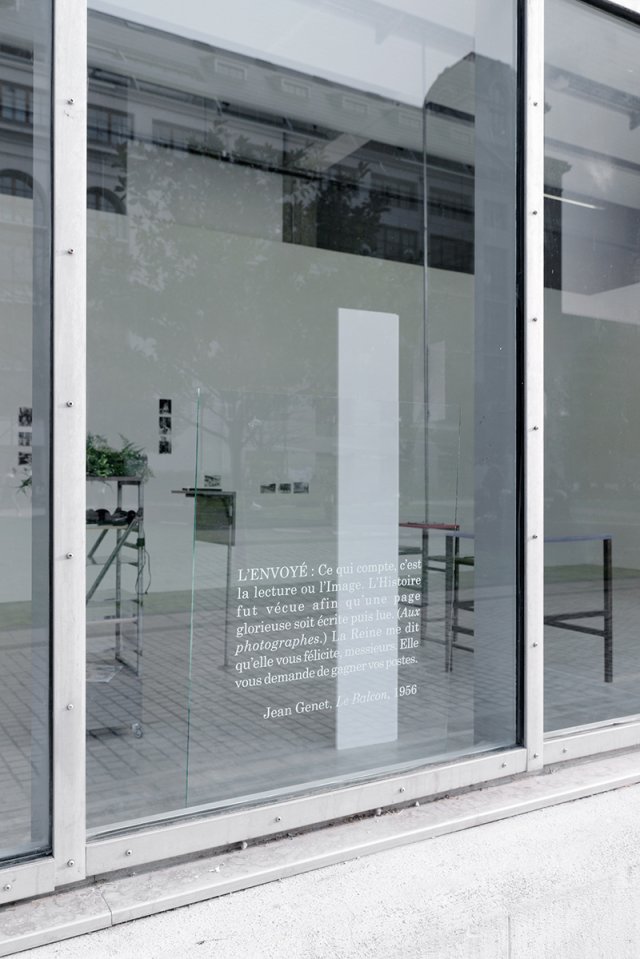
- Maryam Jafri, « The Day After », Exhibition view at Bétonsalon – Centre for Art and Research, Paris, 2015 © Aurélien Mole.
The Day After takes root in Maryam Jafri’s ongoing project Independence Day 1934-1975 (2009-present), an installation composed of photographs taken on the first independence day in former European colonies across Asia and Africa between 1934 and 1975.
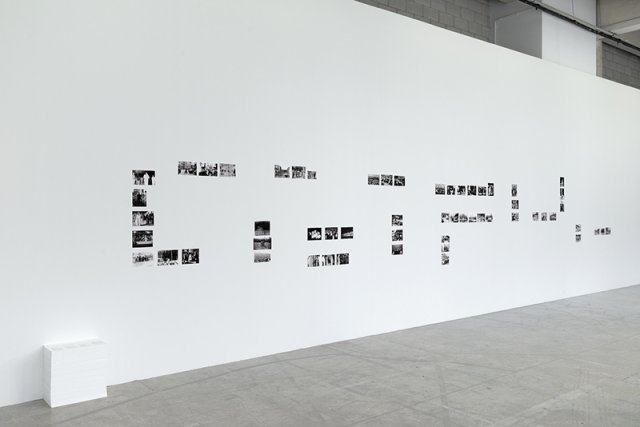
- Maryam Jafri, « The Day After », View of Maryam Jafri "Independence Day 1934-75", 2009 - ongoing, at Bétonsalon – Centre for Art and Research, Paris, 2015 © Aurélien Mole.
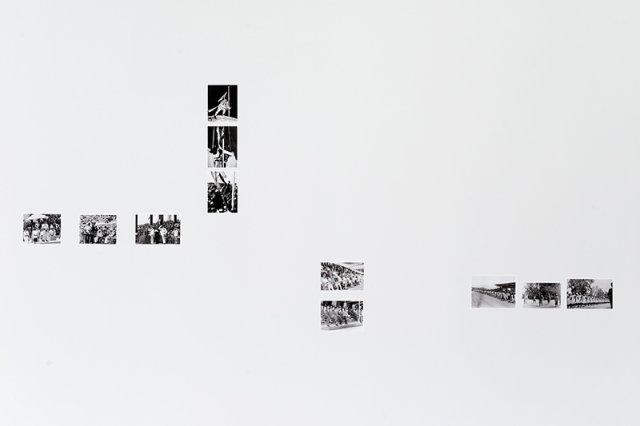
- Maryam Jafri, « The Day After », detail of Maryam Jafri "Independence Day 1934-75", 2009 - ongoing, at Bétonsalon – Centre for art and research, Paris, 2015 © Aurélien Mole.
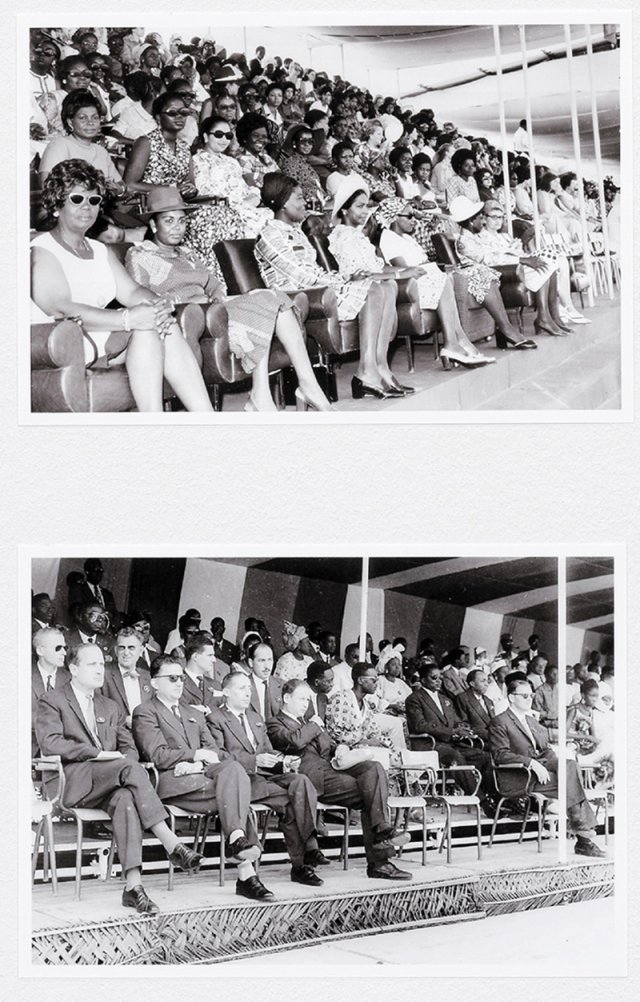
- Maryam Jafri, « The Day After », detail of Maryam Jafri, "Independence Day 1934-75", 2009 - ongoing, at Bétonsalon – Centre for art and research, Paris, 2015 © Aurélien Mole.
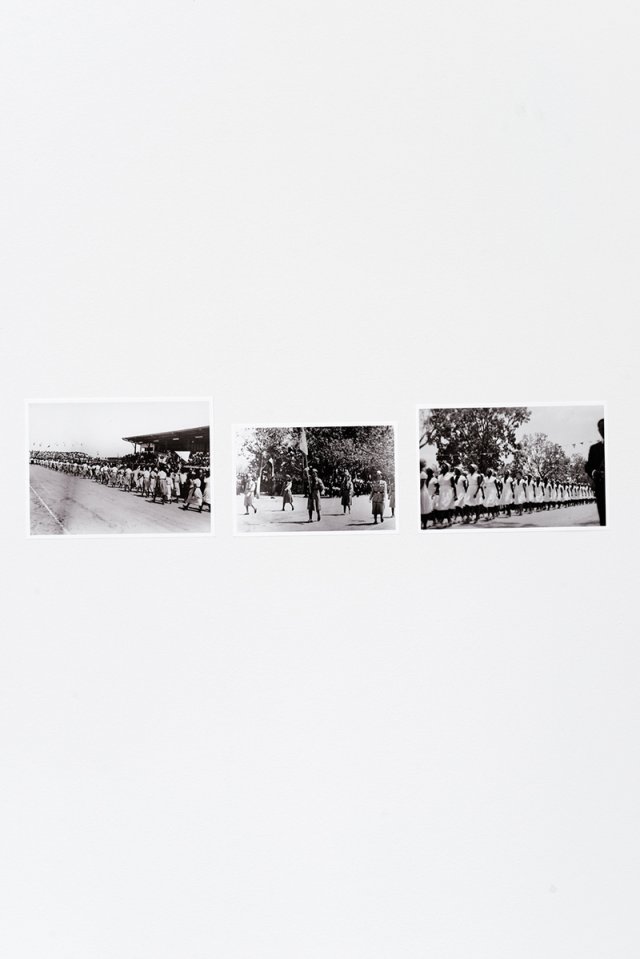
- Maryam Jafri, « The Day After », detail of Maryam Jafri, "Independence Day 1934-75", 2009 - ongoing, at Bétonsalon – Centre for art and research, Paris, 2015 © Aurélien Mole.
The photos are sourced from the countries themselves (in order to highlight, in the artist’s words, “how post-colonial states in Asia and Africa preserve the founding images of their inception as independent nations”) and display striking similarities despite disparate geographical and temporal origins, revealing a political model exported from Europe and in the process of being cloned throughout the world.
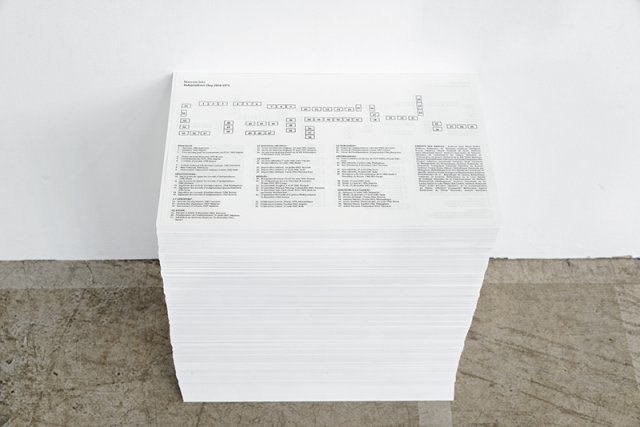
- Maryam Jafri, « The Day After », detail of Maryam Jafri, "Independence Day 1934-75", 2009 - ongoing, at Bétonsalon – Centre for art and research, Paris, 2015 © Aurélien Mole.
Malagasy historian Helihanta Rajaonarison interviewed Malagasy citizens who lived through the events surrounding Madagascar’s independence. Their stories, far removed from the official image of the photographs, reveal the complex and varied way in which these events were perceived, brought back to life through the prism of the photographs.
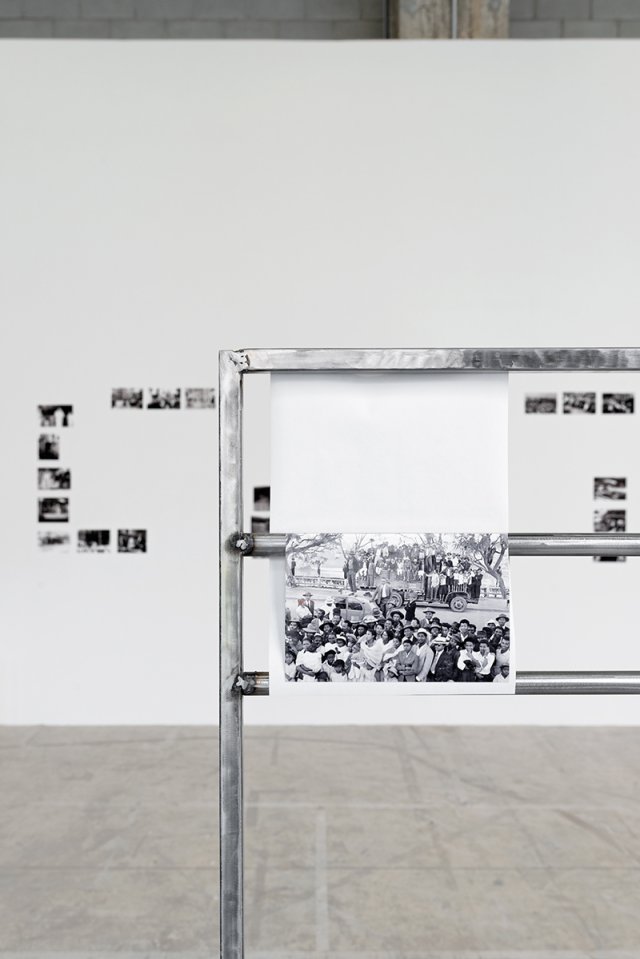
- Maryam Jafri, « The Day After », detail of Helihanta Rajaonarison, photographs from ANTA fund, at Bétonsalon – Centre for art and research, Paris, 2015 © Aurélien Mole.
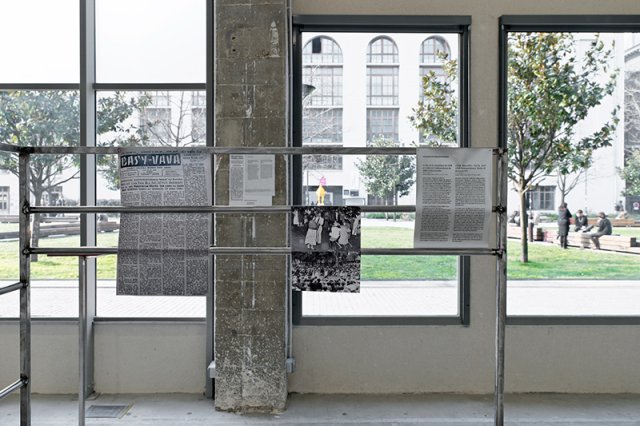
- Maryam Jafri, « The Day After », detail of Helihanta Rajaonarison, photographs from ANTA fund, at Bétonsalon – Centre for art and research, Paris, 2015 © Aurélien Mole.
“One more thing,” states French writer, poet and playwright Jean Genet in How to Stage The Balcony. “This play is not to be staged as if it were a satire of this or that. It is—and will therefore be played as—the glorification of the Image and the Reflection. Its meaning, satirical or otherwise, will appear only in this case.”
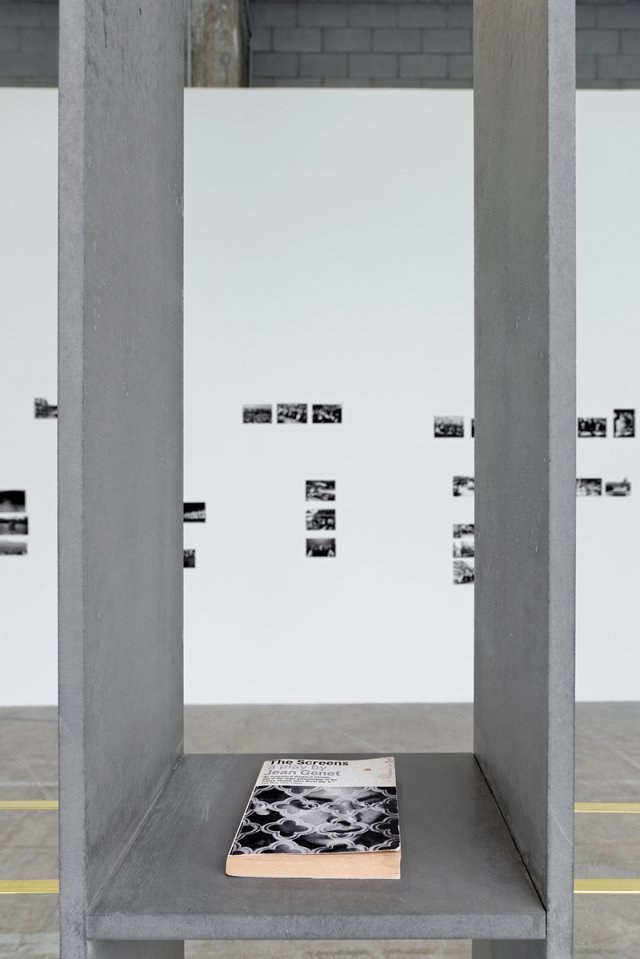
- Maryam Jafri, « The Day After », Exhibition view at Bétonsalon – Centre for art and research, Paris, 2015 © Aurélien Mole.
One independence may hide another... A funny yet bitter tale, Toba Tek Singh was the last short story written by Pakistani writer Saadat Hasan Manto,who was born in British India in 1912 and died in Pakistan in 1955. A thinly veiled criticism of the violence provoked by the Partition, the story depicts the traumatic experience of a man whose identity and homeland are redefined against his will.
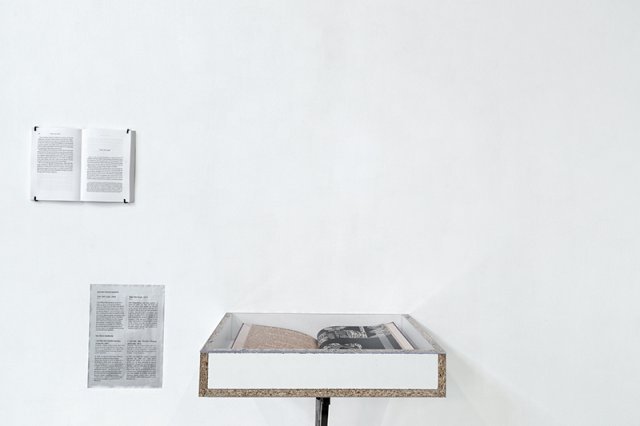
- Maryam Jafri, « The Day After », Saadat Hasan Manto, "Toba Tek Singh", 1955 and "Vrishchik", 1971 (On loan from Bibliothèque Kandinsky, MNAM – CCI), at Bétonsalon – Centre for art and research, Paris, 2015 © Aurélien Mole.
In 1971 the Indian art magazine Vrishchik (founded by artist and critic Gulammohammed Sheikh at the Baroda Faculty of Fine Arts in 1969) dedicated an issue to Bangladesh’s struggle for independence from Pakistan.

- Maryam Jafri, « The Day After », view of "Vrishchik", 1971 (On loan from Bibliothèque Kandinsky, MNAM – CCI), at Bétonsalon – Centre for art and research, Paris, 2015 © Aurélien Mole.
“All public archives in Iraq were presumed destroyed in the 2003 invasion. In 2012, an American company named Tehrkot Media claimed to have some images of Iraqi independence. The images show King Faisal I of Iraq, in his palace gardens, giving an independence speech to a group of British and Iraqi VIPs. In 2014 Tehrkot Media went bankrupt. The site and its images have subsequently disappeared.” (Maryam Jafri)
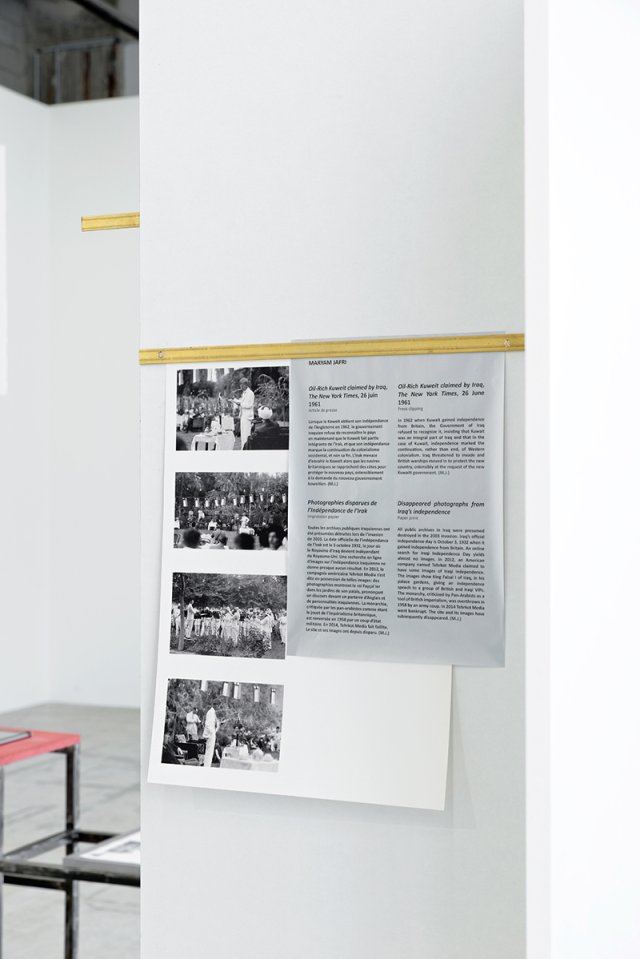
- Maryam Jafri, « The Day After », Exhibition view at Bétonsalon – Centre for Art and Research, Paris, 2015 © Aurélien Mole.
In the years 2010, the economical situation of Portugal led the country to call for help from its former colony, Angola, a country with a rich oil industry. This upsetting of the previous order of things was much debated in the international media.
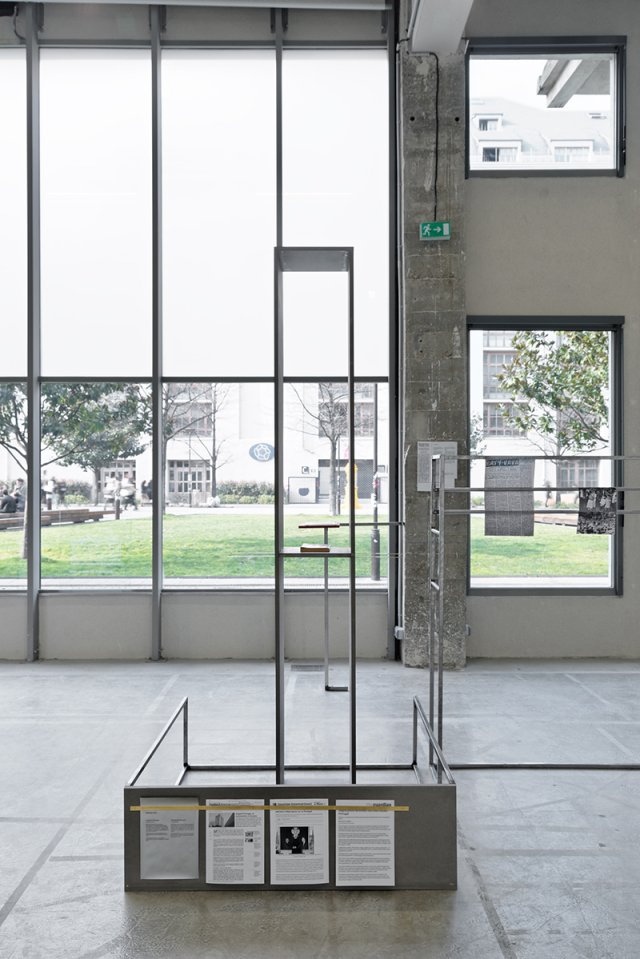
- Maryam Jafri, « The Day After », Exhibition view at Bétonsalon – Centre for art and research, Paris, 2015 © Aurélien Mole.
This photography of Pamphile Kasuku, from Jürg Schneider’s book, La présence du passé. Une histoire de la photographie au burundi, 1959-2005 (Bujumbara, 2008) represents the murder of the burundian prime minister Louis Rwagasore the day after independence. The national leaders death — of which the belgian government is suspected to be a silent partner — has left tensions run between the Tutsis and Hutus in Burundi.
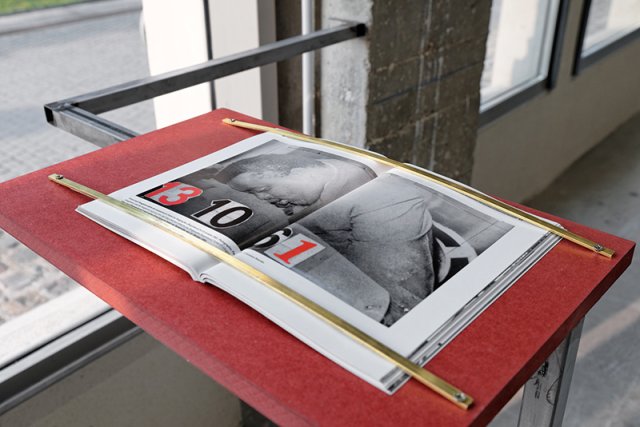
- Maryam Jafri, « The Day After », View of Jürg Schneider, "Présence du Passé" (Bujumbura, 2008), at Bétonsalon – Centre for Art and Research, Paris, 2015 © Aurélien Mole.
In 1960, a wave of decolonization took place in Subsaharian Africa. Fourteen countries became independent, often following peaceful agreements. Students from the Master I Scientific Journalism, Culture and Communication, Paris Diderot University trace out different representations of these events.
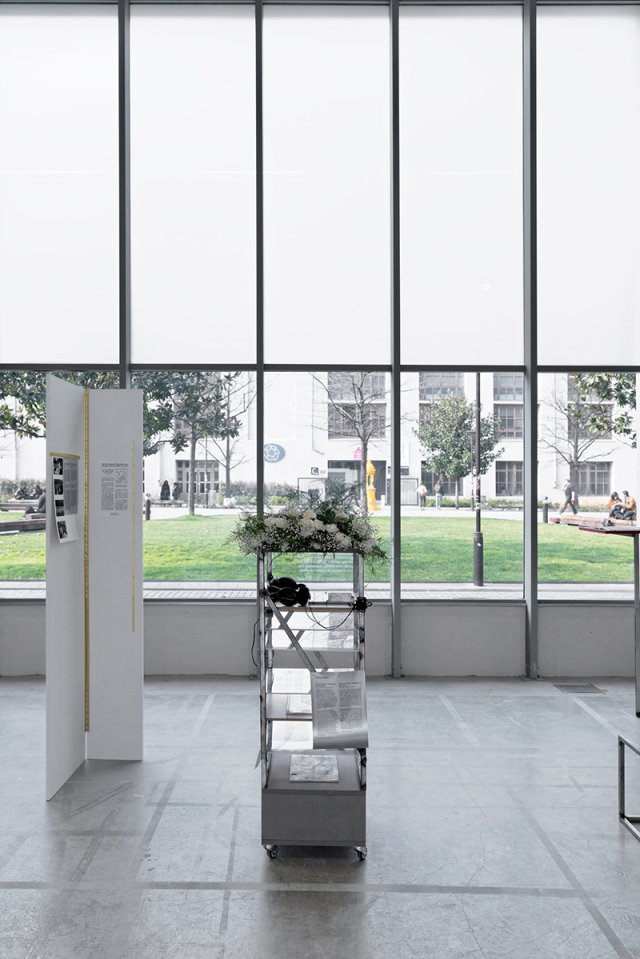
- Maryam Jafri, « The Day After », Exhibition view at Bétonsalon – Centre for Art and Research, Paris, 2015 © Aurélien Mole.
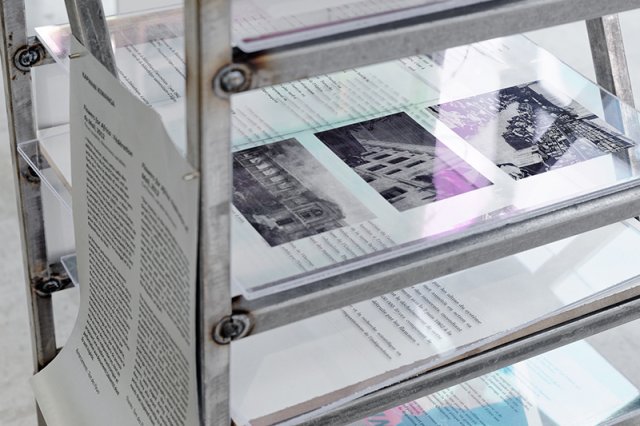
- Maryam Jafri, « The Day After », contribution by students from the Master I Scientific Journalism, Culture and Communication, Paris Diderot University, at Bétonsalon – Centre for art and research, Paris, 2015 © Aurélien Mole.
The bouquet presented by Kapwani Kiwanga, from her Flowers for Africa series, was reconstituted from a photograph of the ceremony of independence of the Federation in June, displaying a choir of young singers holding flowers in their hand. Flowers for Africa comprises several floral compositions linked to independence ceremonies in former european colonies in Africa. Recreated by Kapwani Kiwanga from photographs, these bouquets evoke - by metonymy - the way transfers of powers were staged during independence days. They also enact an anachronistic and performative relationship to the absent documents that inspired them.
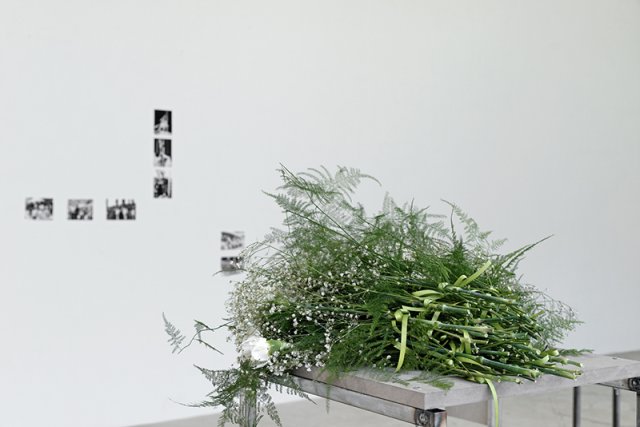
- Maryam Jafri, « The Day After », view of Kapwani Kiwanga, "Flowers for Africa, Federation of Mali", 2012, at Bétonsalon – Centre for art and research, Paris, 2015 © Aurélien Mole.
Misattributed photographs taken by Maryam Jafri at the Jordan National Library and the Kuwait National Oil Company
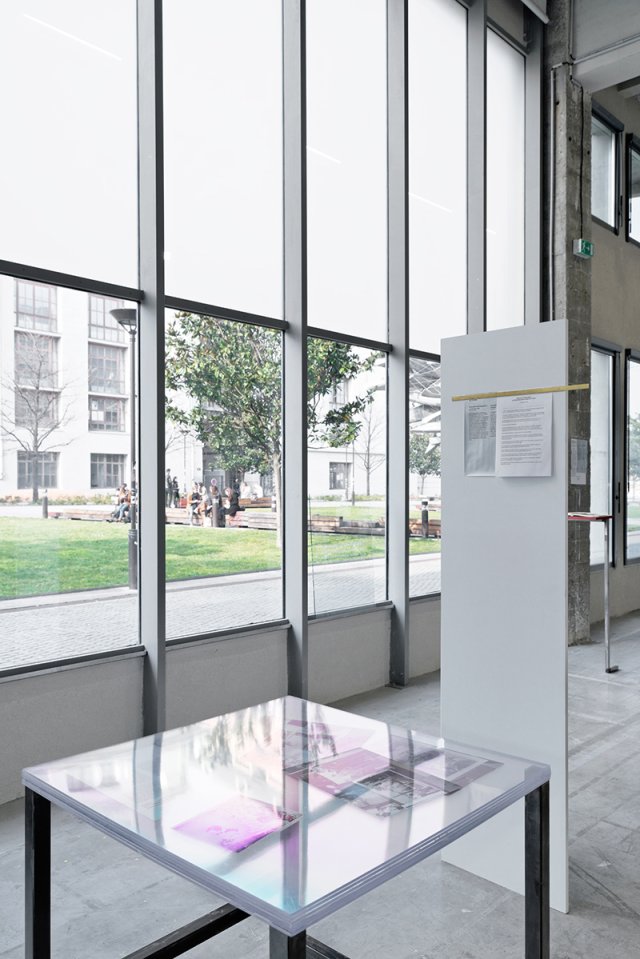
- Maryam Jafri, « The Day After », Exhibition view at Bétonsalon – Centre for art and research, Paris, 2015 © Aurélien Mole.
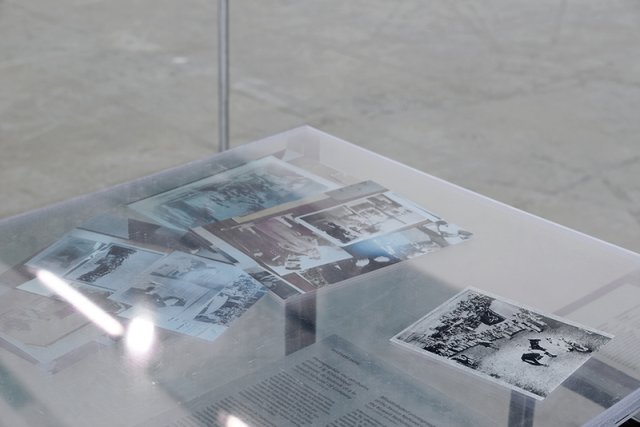
- Maryam Jafri, « The Day After », Exhibition view at Bétonsalon – Centre for art and research, Paris, 2015. Misattributed photographs from Kuweit and Jordan gathered by Maryam Jafri, © Aurélien Mole.
Franck Komlan Ogou (archivist, cultural he- ritage expert, head of program and professor at the Ecole du Patrimoine Africain in Porto Novo, Benin) has spent years working on the preservation of photographic archival collections in Benin. He shares for this exhibition a visual testimony and a conservation project.
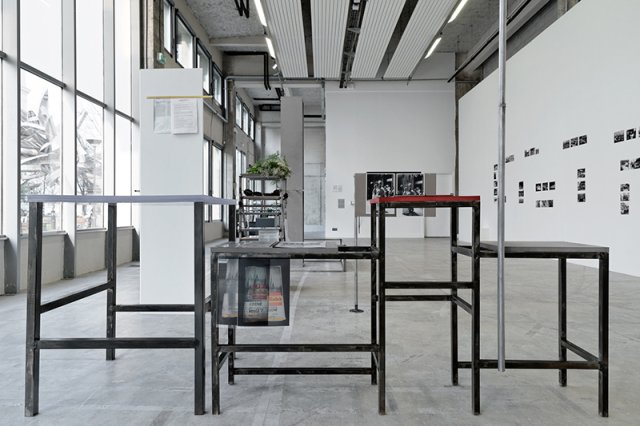
- Maryam Jafri, « The Day After », Exhibition view at Bétonsalon – Centre for art and research, Paris, 2015 © Aurélien Mole.
“Recently, while browsing the Getty Images website, I realized that I had already seen several historical photographs from Ghana that Getty Images had copyrighted at the archives of the Ghana Ministry of Information. The specific images claimed by both Ghana and Getty were not just any images but rather Ghana independence photographs from March 6th, 1957 – documents of the first instance of liberation of sub-Saharan Africa from Western rule. » (Maryam Jafri)
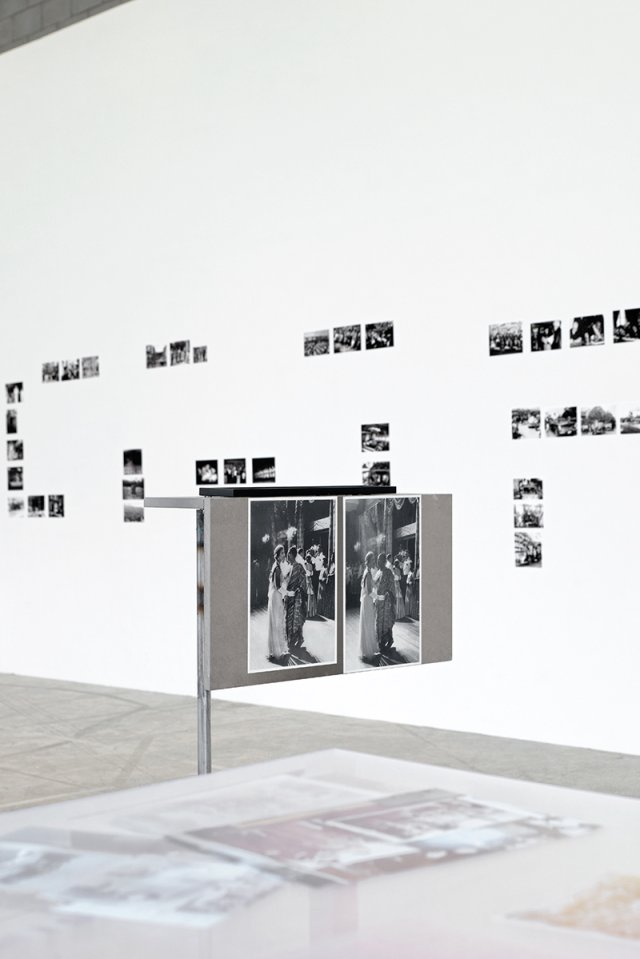
- Maryam Jafri, « The Day After », view of Maryam Jafri, "Getty vs. Ghana", 2012 at Bétonsalon – Centre for art and research, Paris, 2015 © Aurélien Mole.
S.N.S. Sastry worked as a cameraman for the Film Divisions, a governmental organization self-described as ‘the official information organ of India’. He made the film I Am 20 to commemorate the twentieth year of Indian independence (1967), in which he interviews a series of people born in 1947 about their relationship to the idea of India.
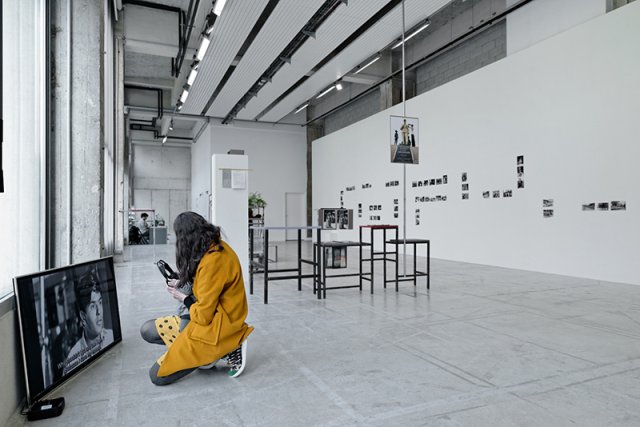
- Maryam Jafri, « The Day After », Exhibition view at Bétonsalon – Centre for Art and Research, Paris, 2015 © Aurélien Mole.
A video, a publication and a sculpture produced by Soufiane Ababri and the participants of atelier Denis Diderot compose a diary of their attempts to “enter history” through a series of actions that are as many efforts to resist the manipulation of history, to speak rather than being spoken.
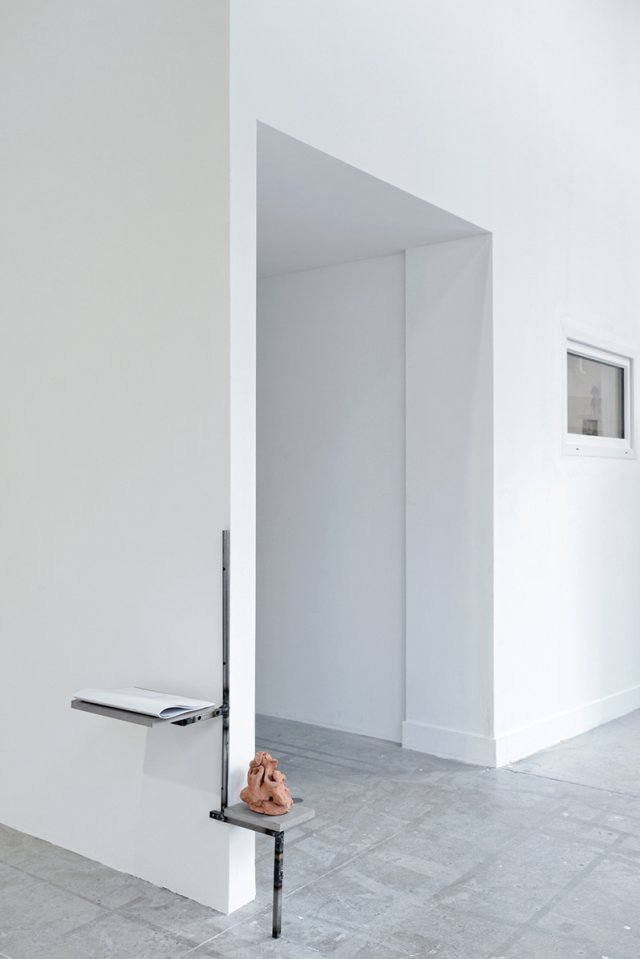
- Maryam Jafri, « The Day After », view of Soufiane Ababri "Des tentatives invérifiables de rentrer dans l’histoire", 2015, at Bétonsalon – Centre for art and research, Paris, 2015 © Aurélien Mole.
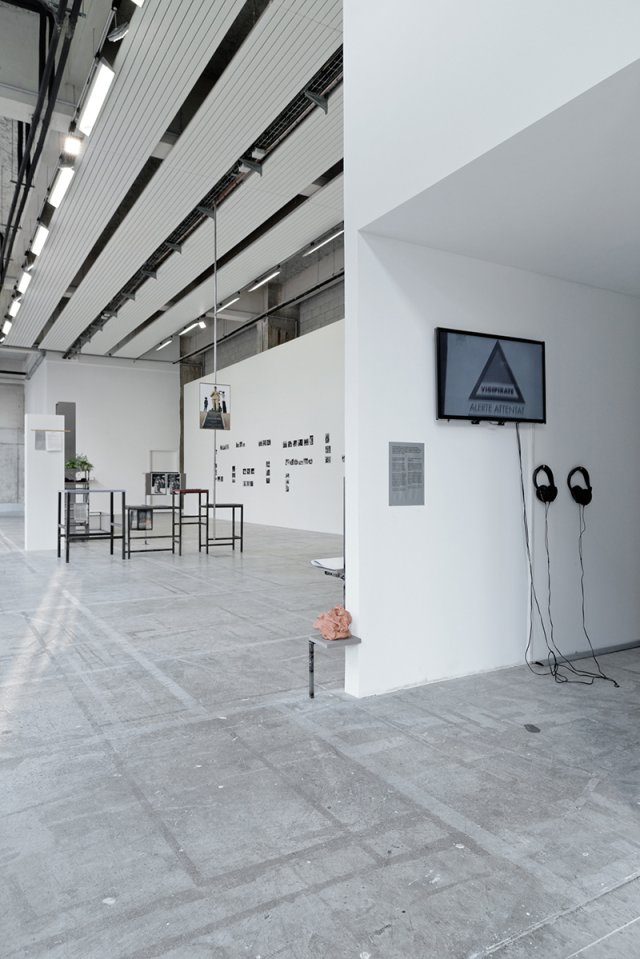
- Maryam Jafri, « The Day After », view of Soufiane Ababri "Des tentatives invérifiables de rentrer dans l’histoire", 2015 at Bétonsalon – Centre for Art and Research, Paris, 2015 © Aurélien Mole.
Researchers Dominique Malaquais and Cédric Vincent and the students of the Master I Scientific Journalism, Culture and Communication Paris Diderot University traced out the many paths taken by the FESTAC mask allowing a new, richly political perspective on, a key moment in the Pan-African euphoria that followed the end of colonial rule.
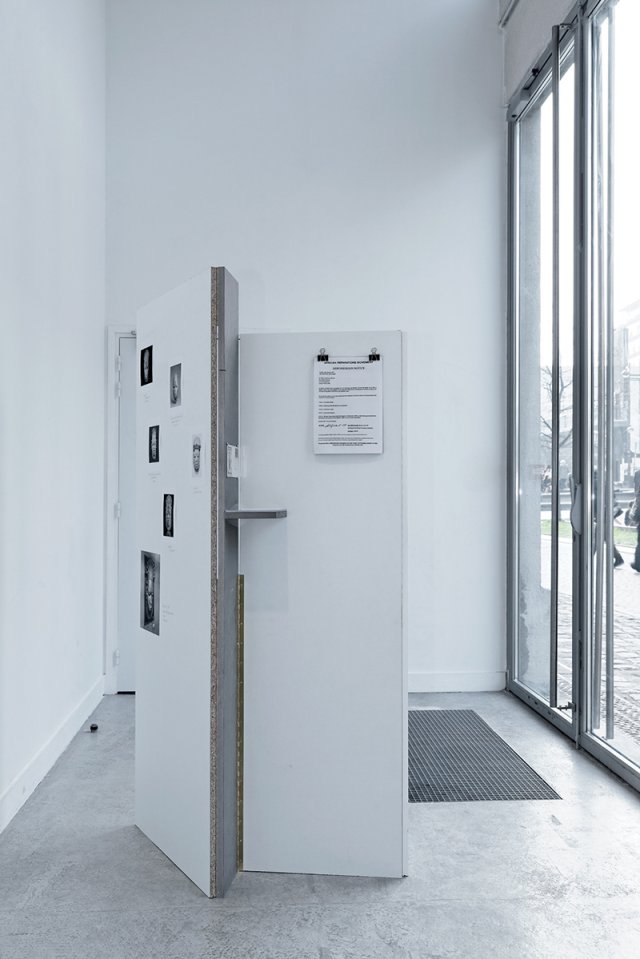
- Maryam Jafri, « The Day After », contribution by Dominique Malaquais, Cédric Vincent and students from the Master I module in Journalism, Culture and Scientific Communication of Université Paris Diderot, at Bétonsalon – Centre for art and research, Paris, 2015 © Aurélien Mole.
The contributions, emerging from the work of participants in the artist’s research over the last few years or invited by Bétonsalon – Centre for Art and Research, seek to trigger a re-examination not only of the photographs themselves—the context in which they were produced and the historical narratives attached to them, but also of their current status, to do with problems of conservation, highlighting property and international issues; and finally of the geopolitical and cultural upheaval caused by the events they depict.
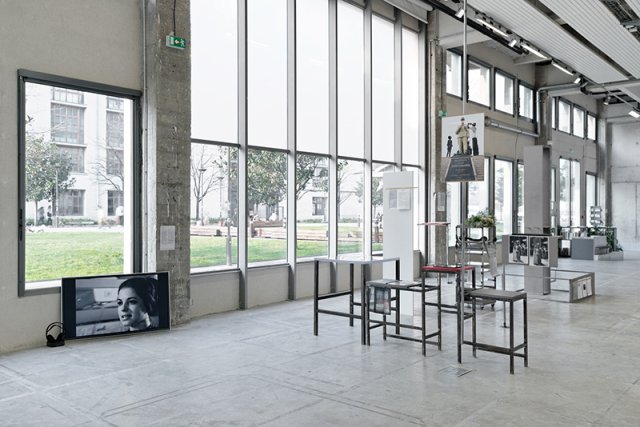
- Maryam Jafri, « The Day After », Exhibition view at Bétonsalon – Centre for Art and Research, Paris, 2015 © Aurélien Mole.
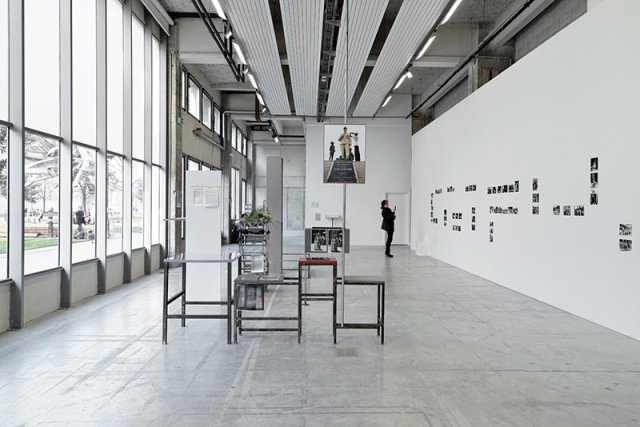
- Maryam Jafri, « The Day After », Exhibition view at Bétonsalon – Centre for art and research, Paris, 2015 © Aurélien Mole.
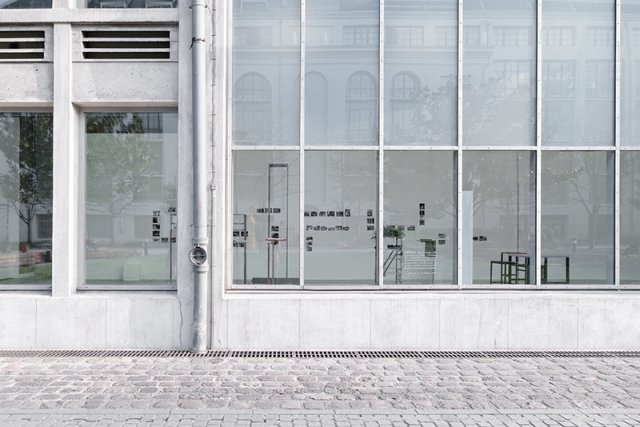
- Maryam Jafri, « The Day After », Exhibition view at Bétonsalon – Centre for Art and Research, Paris, 2015 © Aurélien Mole.
Share